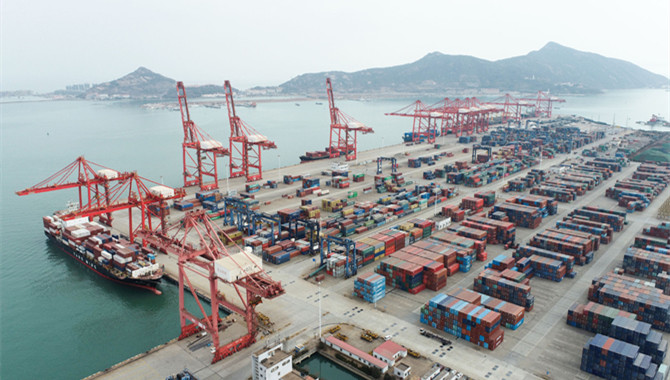
China's foreign trade grew well in the first quarter-up 10.7 percent year-on-year to 9.42 trillion yuan ($1.48 trillion)-but factors like weakening overseas demand don't bode well.
In fact, they already have had a downward pressure on exports, judging by the changes in trading partners and exports of major products.
When the global COVID-19 pandemic situation appeared to have eased, the production capacity of Southeast Asian countries, especially Vietnam and Thailand, continued to recover, but squeezed the export share of China's labor-intensive products.
Add to that the weakening overseas demand for Chinese anti-pandemic supplies, and it would become apparent the peak period of inventory replenishment in the United States, the European Union and many other parts of the world has passed. This has further cut Chinese manufacturers' orders, especially for goods related to the so-called stay-at-home economy.
Exporters worry that COVID-19, geopolitical headwinds and surging commodity and energy prices may slow the momentum of global economic recovery, potentially lowering the growth rate of global trade volume.
Owing to the slow progress of vaccination and limited policy support, emerging economies' recovery has been notably weaker than that of developed economies. However, be it in terms of consumer demand or replenishment demand, the recovery of developed economies will likely have a limited impact on China's exports in the following months.
So, many research institutes and experts hold the view that China's export growth speed and global share will continue to rise, albeit at a modest pace.
Because vaccination rates in developed countries are significantly higher than those in other countries, the impact of the COVID-19 outbreak on the former is fading more quickly. The recovery of consumption, especially in services, which is determined by economic structures, is still the key to realizing an economic recovery. This will continue to highlight China's production advantages and its growing role in global supply chains.
Whether or not people accept, fact is that many countries have a strong dependence on Chinese goods. That's because China has ensured reliable shipping times and product quality in previous months, which helped them in their fight against the disease. This factor will help delay the drop in China's export share in the global market.
Elsewhere, the Regional Comprehensive Economic Partnership agreement, which took effect at the beginning of this year, has created a super large integrated regional market, which is expected to inject vitality into the global economy amid the resurgence of COVID-19.
Supported by the RCEP's common rules around trade, intellectual property, e-commerce and competition, this integrated market is bound to bring about huge trade creation effects, indicating intraregional trade increments in China, Japan and the Republic of Korea.
To make the most of such a scenario, China's export-oriented companies must strengthen their awareness of internationalization, study the terms of the RCEP, fully understand the free trade agreement and apply the common rules of origin under the pact to cut costs as well as optimize the allocation of resources like capital, technology and talent.
To better confront challenges, they should also actively cultivate internal skills. The current situation requires them to focus on emerging fields and strive to develop markets via innovation and change. They can avoid homogeneous price competition and allow the market to value the differentiation and uniqueness of their products made possible by the accumulation of technology and patents.
Many domestic exporters have repeatedly said they will deploy more resources to the task of growing the domestic market. They must walk the talk and master the strategies necessary to operate in such a huge and complex market.
As the value chain of their foreign trade business is mainly formed by relatively simple procedures, which range from gaining raw materials and organizing manufacturing work to shipping products to overseas clients, they would do well to understand domestic retail demand, consumers' shopping preferences, government regulations, and sales modes in brick-and-mortar stores and on online sales platforms.
Source: Chinadaily
The opinions expressed herein are the author's and not necessarily those of The Xinde Marine News.
Please Contact Us at:
media@xindemarine.com


 Ningbo Containerized Freight Index Weekly Commentar
Ningbo Containerized Freight Index Weekly Commentar  Ningbo Containerized Freight Index Weekly Commentar
Ningbo Containerized Freight Index Weekly Commentar  Ningbo Containerized Freight Index Weekly Commentar
Ningbo Containerized Freight Index Weekly Commentar  BIMCO Shipping Number of the Week: Bulker newbuildi
BIMCO Shipping Number of the Week: Bulker newbuildi  Ningbo Containerized Freight Index Weekly Commentar
Ningbo Containerized Freight Index Weekly Commentar  Ningbo Containerized Freight Index Weekly Commentar
Ningbo Containerized Freight Index Weekly Commentar